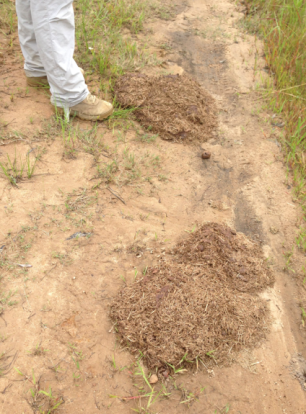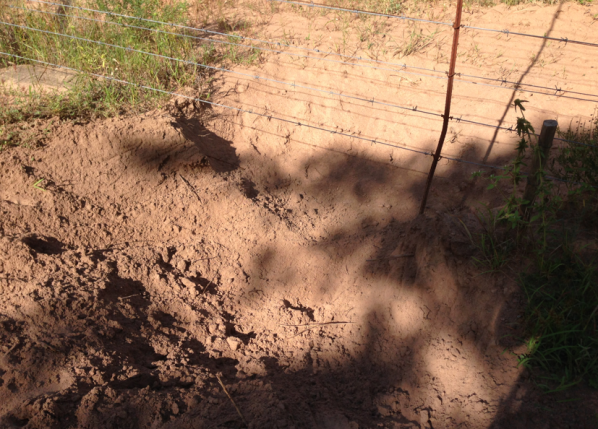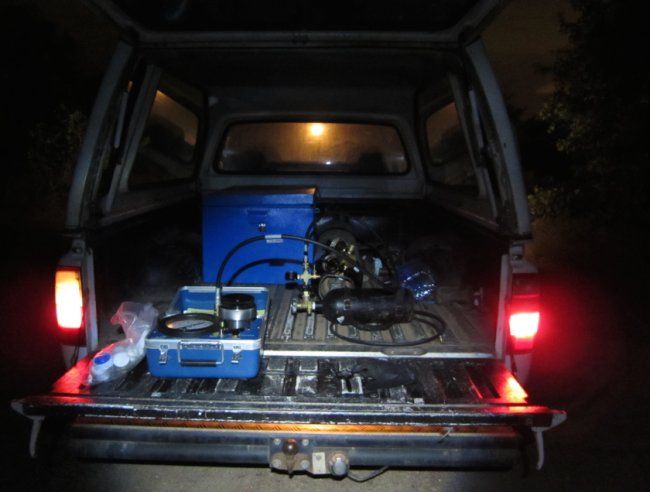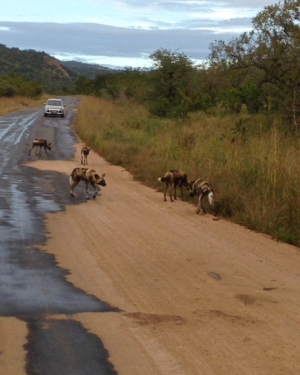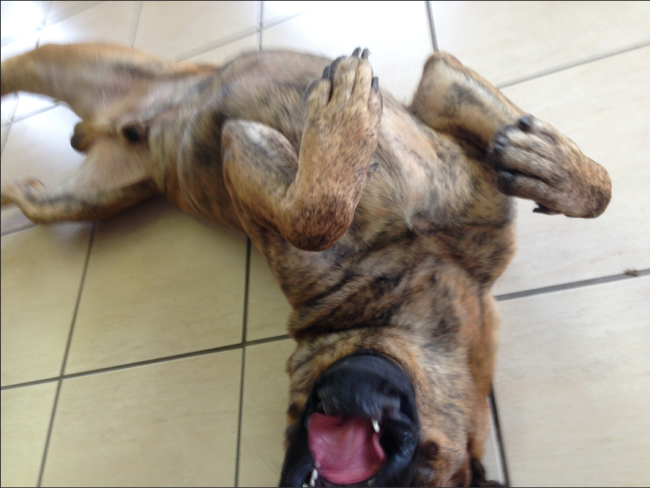(Warning, post contains off-color language)
Whether you study polar bears or pond scum, field work always comes with its fair share of stories: interesting, hilarious, amazing, ridiculously terrifying or more often some mix of the above. Here are the highlights from the 2014 field season (at least so far!)
– Close encounter of the mongoose kind:
It was the end of our first month at the Wits Rural Facility, a private field station owned by the University of Witswatersrand, approximately an hour West of Kruger National Park. While we had visited the park once or twice, most of the field work up until this point had been done at the Wits facility. Generally WRF is used by students and researchers working at the local hospital or doing social work, however the property also includes vast tracts of untouched savanna, perfect for aspiring ecologists. It’s especially ideal for our purposes because, while it does have the usual assortment of antelope, giraffe, zebra, wildebeest, etc etc, the real killers of the savanna including Elephant, Rhino, Lion, Leopard and Cape Buffalo (aka the Big 5) are (usually) missing.
This means that we can walk around and do field work without a game guard and only be mildly in fear for our lives. Mildly, because there is of course your dangerous staples, (puff adders, black mamba, and similar) but also because even electric fences only go far to keep out elephant and leopard. Hyena also love to dig under the fence at every opportunity, which allows access to their leonine rivals. In fact, Wits Rural was at that moment hosting a runaway elephant inside the grounds, as well as a booming leopard population up at another of our sites. While we didn’t confirm this until later, we did notice some signs….
Maria: Why are you taking pictures of elephant poop? It’s not like we haven’t seen it a thousand times befooooh shit.
Oh shit indeed.
Still, the facility is very, very large, and as long as we took proper precautions and didn’t go out alone at night, it was more or less safe enough. I instructed Maria in all the tricks you can use to survive an aggressive Big 5 encounter (a short list, but that only means it’s easy to remember), and we stayed together and hoped for the best. Then, one day, everything changed…. (yes, the heading of the section should have ruined all suspense, but allow me my dramatics).
We were at the T site (T for trough, because there was an old trough in the middle of it), and had been working furiously all day; measuring, hammering, flagging, etc. There was a giant marula tree growing in the middle of a thicket (they tend to do that), and since it was the only marula tree at the site, I resigned myself to fighting my way through the bracken, donating some blood, and eating a bug or two. Once I was in I was reluctant to fight my way out again, and so cast around for other likely trees to measure (confession, this is how most of our trees get chosen). As I was eyeing a likely candidate, I heard rustling in the underbrush. It came closer, and closer, and then…!
Close Encounters of the Mongoose Kind [Video]
Bonus Footage: Baby Mongoose in Skukuza Rest Camp [Video]
– Well that escalated quickly:
As I mentioned, we generally do what we can to play it safe, but sometimes the work just needs to get done. Without question, the most dangerous thing we do is take pre-dawn water pressure measurements. Imagine a tree. The tree somehow needs to get water at its roots all the way up (sometimes over 20 meters) to its leaves for photosynthesis. Have you ever wondered how a tree does that? Well, I won’t got into the technicalities here, but an apt metaphor is the leaves suck the water up, as if through a straw. If you remove a leaf from the tree it will continue to exert this suction force, even though it’s completely detached and soon to die.
If the tree is water stressed, for instance if there is a drought, it has to suck much much harder to get what scarce water there is out of the ground. Some trees are better at this than others, and so some need to exert a strong suction, while others don’t need to work as hard. A clever way to measure this is to remove a leaf, stick it in a pressure chamber, and “squeeze” it with increasing amounts of gas. However much pressure it takes to squeeze out the water, that’s the amount of suction force the leaf had been exerting when still attached to the tree. In this way, you can get a good idea if a tree is water stressed or not, and unsurprisingly the technique is used mainly by agriculture workers, especially in vineyards. It’s one thing to compare one grape vine to another, but if you’re comparing across different tree species, you need some sort of baseline with which to put your values in perspective. That’s where pre-dawn measurements come in.
Theory and specifics aside, the important thing to know about pre-dawn measurements is they take a long time to do, and they aren’t very forgiving. They are very much pre-dawn, in that as soon as the first bit of light hits the sky, that’s it, you’re done. Measuring any further will make the numbers screwy. So, while the ideal time to take pre-dawn measurements is around 4am, in actuality we’re trucking out there at around 1. Keep in mind that we have many, many trees to do. Even in pairs this is dangerous. Night time is when the hunters are out, when line of sight is non-existent and all the sane creatures are asleep. When Maria and I did pre-dawn measurements at the leopard site it was probably one of the most nerve-wracking experiences of the season. Then we started working in Kruger, where taking pre-dawn measurements wasn’t only stupid, it was plain out suicidal. But, as previously mentioned, the work needed to get done. In Phalaborwa, there is a slice of savanna in between the research office and the small neighborhood where the workers live. True, this piece of land isn’t gated, but it’s right on the Western boundary of the park and surrounded by people. If any place was “safe enough” to do pre-dawn measurements. It was here. Unfortunately, Maria wasn’t around that week, being in Cape Town with her dad, so I had to go it alone. You can probably see where this is going.
Even sitting in the car, staring out into the darkness was terrifying. I’m not a jumpy person, and I’ve put myself in all sorts of foolish situations before, but somehow this was calling up a primal fear that was hard to push down. Not helping matters was the fact that it was incredibly windy. I had comforted myself before with the thought that I’d probably be able to hear something large approaching, but in that wind I’d be lucky to hear if the tree I was measuring was about to crack and fall over. After about ten minutes or so of working up my nerve, I got out of the truck, leaving the lights on, and started assembling the pressure chamber.
Normally I take the pressure chamber and nitrogen cylinder out into the field with me, and I had every intention of doing so, but imagining myself out in that blackness, bent over a gauge with my back to the savanna and just a bitty flashlight for company ate up any nerve I had to spare. So I kept it at the truck, deciding it wasn’t that big of a deal to do some extra walking.
As I was making my way to my first tree I noticed some eye shine glowing out from the depths of a shaggy mopane tree. It wasn’t large eye shine, I knew right away it must come from an insect or a rodent, but the effect was downright spine-tingling. I decided I needed to capture that eerie sensation for posterity. I walked over to the mopane but the eye shine was comping from its depths and I just couldn’t bring myself to get closer. Instead I noticed an unassuming little moth perched on a nearby leaf, and since it was giving off eye shine as well I thought that would do as a substitute. The wind was making focusing difficult, so I switched to taking a video. That’s when I heard it.
Something moving. Something BIG. Something right behind the mopane tree. I froze, stopped filming, and began to back up toward the truck. Whatever it was, it was upwind of me, which to this day I thank my lucky stars for. I was just trying to decide if I was overreacting or not when a big gust came, blowing right in my face, bringing with it the smell of heavy musk. “Oh fuck,” I thought, “elephant or buffalo. Please god don’t let it be elephant.” That’s not to say either wouldn’t have been a problem. Buffalo are far and away the most feared of the big 5 among the game guards. They are deadly, but more importantly, they are incredibly unpredictable. Unlike elephant or lion, which might warn you off once or twice, buffalo can just charge, leaving you no time to respond. But by that point I was close enough to the truck that a buffalo was the lesser of the two dangers. My truck would stop a buffalo. My truck would not stop an elephant.
I got to the truck, quietly worked the door open and stood half in and half out, trying to see what was out there. A few months ago, a tourist was hospitalized after an elephant attack in Kruger, and she was lucky. The car had been too close, and the elephant had been a male in musk. It flipped the car, gored it, and one of its tusks went right through the woman’s thigh. I thought about this, and again cast thanks upward that I was upwind. You see elephants have fairly poor eyesight, not unlike the t-rex from Jurassic Park. If it was an elephant out there, I’d be very hard to see in the dark. Just the last week Desmond had told me a story about another elephant attack. In this case a group of tourists went out on a guarded morning hike. They surprised an elephant and when the elephant charged one of the tourists broke away from the rest and ran. Unfortunately she ran downwind. Elephants may not be able to see 20-20, but they can track frighteningly well by scent. The elephant veered off and made straight for the running tourist. The tourist was wearing a backpack and when the elephant lunged at her its tusks went directly between the straps and her shoulder. It lifted her clear off the ground. It was about to dash her back down when one of the rangers shot it through the head. It collapsed and fell on the woman, but miraculously she was found in the space between its shoulder and its jaw beneath its neck. She was completely unharmed. In both of the above stories the people involved had been incredibly lucky, and so you can see why I was hoping for a buffalo.
Part of me still wondered if what I was hearing was just a kudu or other large antelope. Was it really worth abandoning an entire nights work, that couldn’t be replicated, over a what-if? The answer is ‘Yes,’ of course, a resounding yes, but if possible I wanted to get some physical evidence that I had ample reason to leave and wasn’t just being derelict in my duty. The other thing to consider was if it WAS an elephant, turning on the car would be a very bad idea. Elephants are pretty laid back creatures until you startle them or make them angry. My truck was pointed toward a dead end and to reverse I would have to stick my head out the window, plus I had literally thousands and thousands of dollars worth of equipment precariously perched on the tailgate. I couldn’t just take off, and even if I did I might startle an elephant and have nowhere to go. So I waited, hoping to figure out just what it was I was dealing with.
Frightening as all that was, not long afterward I heard something cross the road behind me, out of reach of my flashlight or the brake lights. That was terrifying as well, but I thought I heard the sound of a hoof strike rock. “Buffalo,” I thought, “thank god.” If it was buffalo I was safe. Even if they charged me I could just jump back into the truck. So, first thing first, I needed to put away the pressure chamber. There was no way to do this quietly, so I settled on quickly. I untwisted valves, detached metal fittings, pushed the pressure chamber and nitrogen cylinder across the truck bed, slammed shut the tail gate, secured it on both sides, crashed the window portion closed and spun around with my heart in my mouth. Dead silence. No surprise there. But as I was making my way back around the truck I thought I heard something approaching, perhaps curious as to what was making all the noise. I ripped open the door but was again startled by something snapping behind me. It was my friend from behind the mopane tree. I spun, searching for movement, didn’t see anything, turned back, and came face to face, so to speak, with a 8 meter tall elephant standing right on the other side of the truck. I dove across the seats, literally dove, curled in my legs and gently worked the door closed. Luckily the passenger side window was closed, the elephant couldn’t smell me, so we spent a few moments gazing at each other through the window. There was another large crash and snap and then a second elephant came out from behind the mopane tree. The one I had been standing next to not too long ago. And so, that’s how I realized I was surrounded by elephants.
I never saw more than 3, but I heard them out there in the darkness. They were all females as far as I could make out, though the only ones I could see were the ones standing near the car headlights. I sat there for what felt like 40 minutes, too afraid to turn on the car, all the while wondering if the battery was going to die but too afraid to turn off the headlights either. Again, driven by the need to get proof that this actually happened, I shot this video out the other window.
When the elephant herd finally moved far enough away that I felt comfortable turning on the engine, I crossed my fingers, made two attempts at turning the key due to my shaking, thanked god when the engine caught, and then got the hell out of there. When I got home, a distance of maybe 500 measly meters, I noticed a hint of light in the sky. It was 4am. I had been out there for 3 hours. Even now I remember the vertigo. If you had asked, I would have told you the whole thing couldn’t have taken more than an hour at most. Adrenaline is a funny thing.
– Welcome to the Set of National Geographic:
Only a few days later I was making the long drive from Orpen Gate to Skukuza. I was in a bad mood. Maria and her father were back, and they had seen cheetah the previous day. I still have yet to see a single bloody cheetah in Kruger (Maria graciously lent me the title picture). They had seen 3. I had also made this same exact drive, a trip of over 8 hours, the day before. Eight hours in the park without seeing anything (well, impala of course, but who counts them) And here I was doing it all over again and with just as much luck. The reason for the dual trip was prosaic and mundane and I won’t bore you with it. But it was nothing fun and several logistical things had gone wrong, which brings me back to the original point, which was I was in a bad mood.
Then I used up 20 years of good karma in a single instant and it was all worth it.
The buffalo was the first thing I saw, just in a casual scan of the side view out the window, and I was about to bypass it (buffalo are cool but seen from the car they lose some of that life or death immediacy when encountered elsewhere) when I saw just the hint of a tawny ear. I was driving over 80km/h and so by the time the right neurons fired I was already well past it. I skidded to a halt and threw the car into reverse, backing up close to a hundred meters. And there they were, four lionesses at the end of a long battle with a buffalo. Everyone involved was obviously exhausted, and as with workers gathered together to dig a hole or fix a fence, only one person was working while everyone else watched. I still don’t understand how the lioness beneath the buffalo didn’t get her spine broken or a hoof through the rib cage. Talk about occupational hazards. When it was finally over and the lioness succeeded in suffocating the buffalo (that’s usually how they bring them down), the buffalo fell behind a bush which I was honestly not too upset about. Real life is all fine and good, but part of me had been rooting for the underdog here.
It was only after the buffalo fell that the cubs came out. They had been hiding in the grass, but now all three came out for a lesson in bringing down a kill. None of them were very good yet, and of course aunty had already done all the hard work, but the buffalo was still alive so I suppose the exercise was instructive. Again I was rather glad to only have to see the occasional kicking hoof. One amazing thing about the whole event (beyond the obvious), is I was utterly alone until well after the hunt was over. Most of the time Kruger can be a bit of a Disneyland parade, which is why I don’t always recommend it as a tourist destination for the more outdoorsy of my acquaintances (see video below). But in this case it wasn’t until the lionesses had settled in for their meal that the first car arrived. With the one came several more, so I left not long afterward, not wanting to hog a good viewing location when I had already seen more than my fair share of the action. Needlessly to say, my mood had improved quite a bit.
– The Very Best and Worst of Kruger [Video]
Addendum: Not long after this, Maria and I were lucky enough to encounter wild dogs again. I was driving and Maria left her camera in the back of the truck so there aren’t any good pictures, which is truly unfortunate because right after we spotted them, they took off after a herd of impala! They chased the impala right past the truck, but unfortunately from there off into the bush, so we never found out if the hunt was successful.
If you’ve read this far, I hope you enjoyed some of the highlights! More soon!

